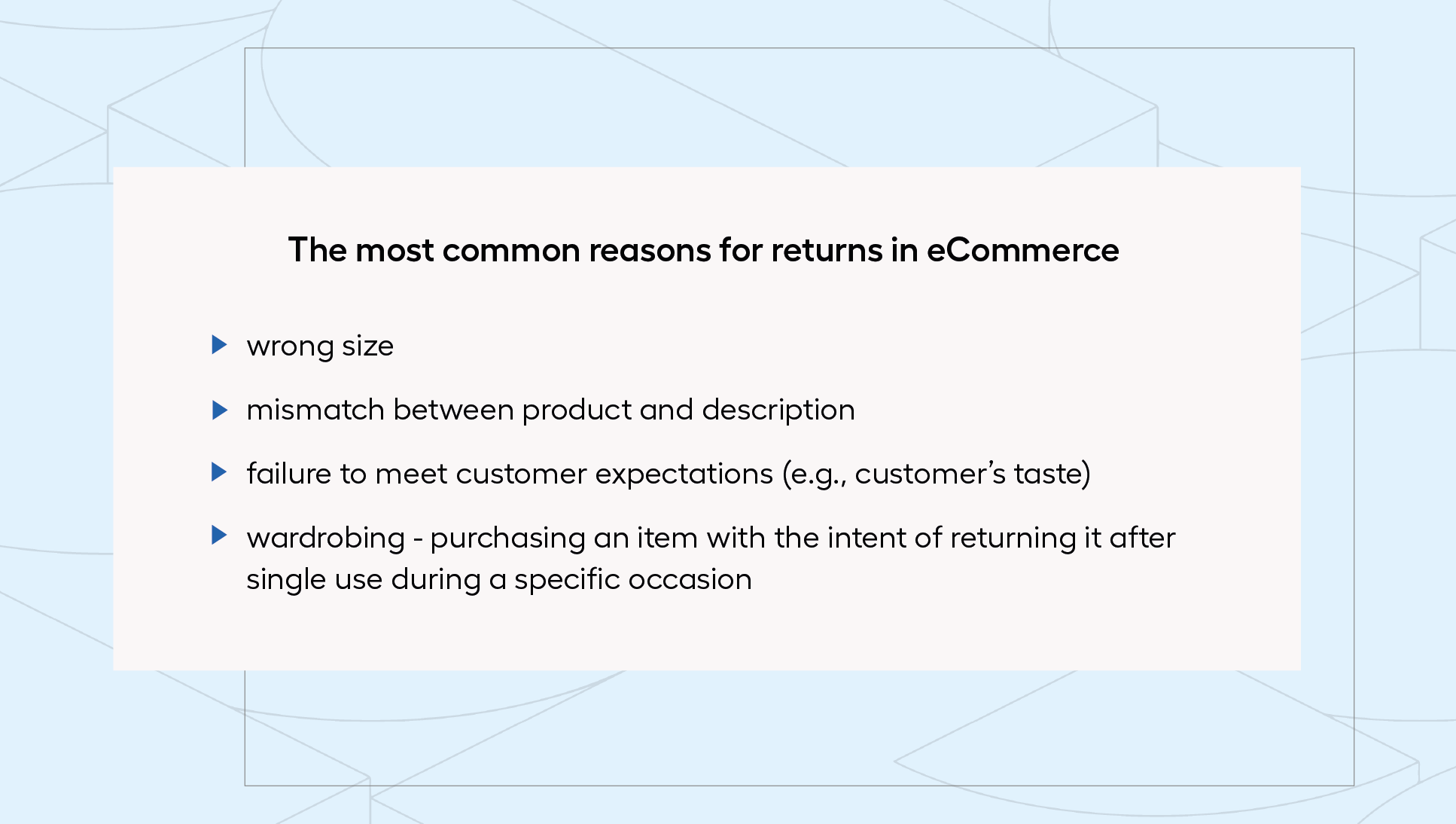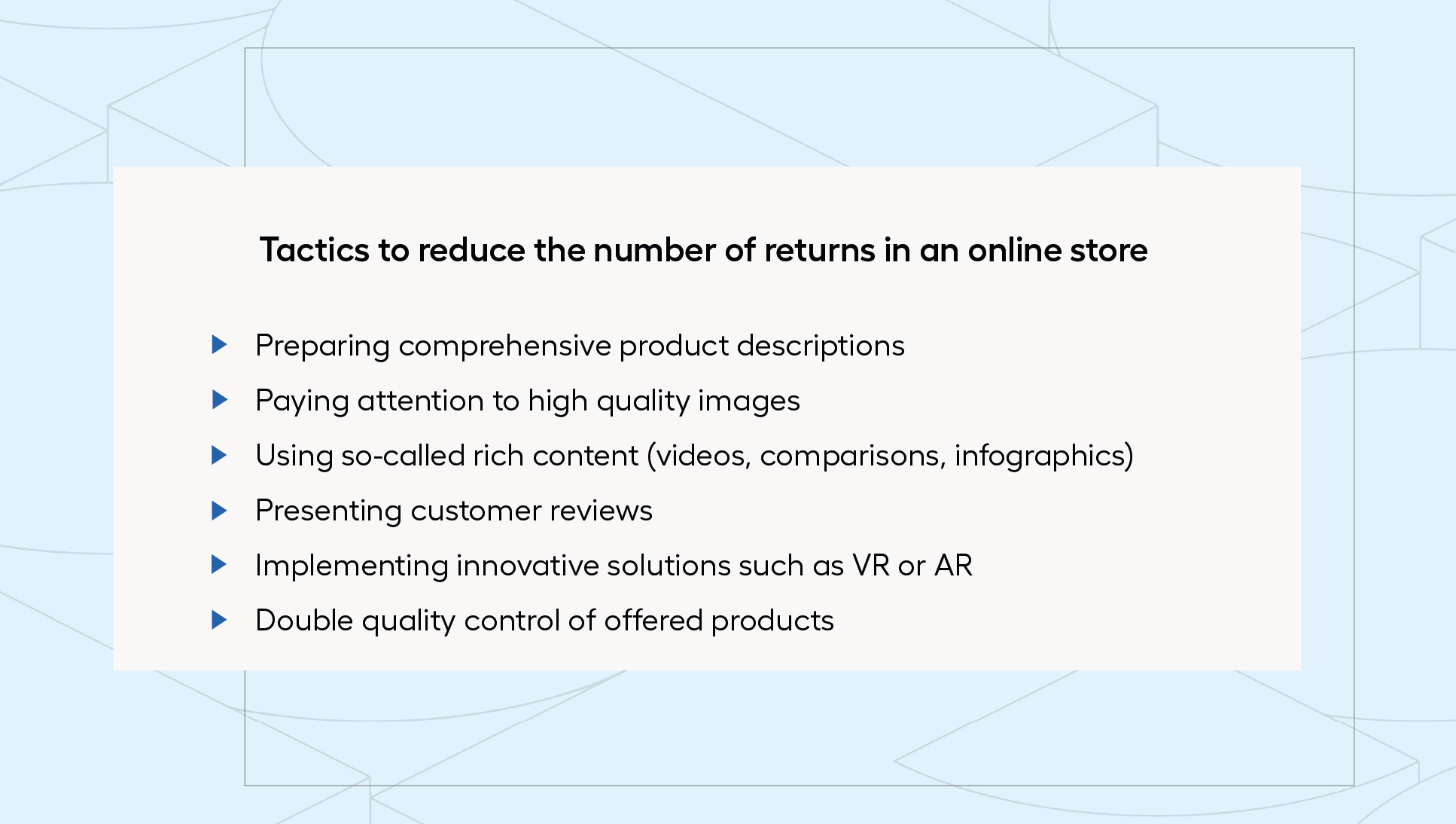When you run an online store, your biggest focus is, of course, on increasing your sales as much as possible. You look for all sorts of ways to encourage customers to make a purchase - through marketing campaigns, up-selling and cross-selling activities, or with the help of properly optimized ads targeted to your audience. But have you ever thought that you can also increase eCommerce sales by reducing returns? After all, there's no denying that products sent back to an eCommerce store represent lost profit, to which there is usually another cost as well (in the case of the possibility of free return, which online stores are now increasingly daring to give up) - for this reason, it's worth looking for ways to minimize returns in eCommerce. Here's a look at some of the best actions you can take in this area.
Why do customers return products?
The catalog of reasons why customers return products can in fact be unlimited - starting with the most common reason, i.e. the wrong size (about 50% of returns), through non-compliance with the description (e.g. a different shade of the indicated color), to the usual "mismatch of taste". Among the returns, we also find goods bought for a gift that did not meet the expectations of the recipient, or products purchased for a special occasion (such as a vacation, wedding, etc.) that are no longer, due to unforeseen events, needed. Another factor contributing to later returns in the case of the fashion sector is so-called wardrobing, i.e. acquiring goods in order to use them once and return them (e.g. an elegant dress after a one-time dinner or family event).
Because of such a wide catalog of reasons, it is definitely worth encouraging the customer to fill out a post-purchase survey each time, in which he or she can give a reason for returns. If the reason behind the cancellation of the purchase is the answer "I don't like the product," then of course your options for action in this regard will be limited - the only thing you have no control over is the fit to the customer's individual taste or the fact that it lies badly on his or her particular figure. However, in the case of another response, you can check whether it is repeated too often, and if it is, take appropriate steps to improve the situation, which should be part of your eCommerce returns reduction policy.

Limiting returns in eCommerce - what can you do?
Undoubtedly, you will never be able to completely eliminate returns in your online store - after all, it is a specific feature of online shopping to receive products that do not meet the customer's expectations, due to the lack of opportunity to try them on or check them before purchase. However, you can implement tactics that will help you minimize this number, with positive results for your business. How can you do this?
Online stores very often think that the easiest way to reduce returns is to force customers to pay for them. However, this is a short-term tactic, which in the long run can provide you with completely the opposite effect - as paid returns are an element that can discourage the customer from making a purchase on your online store and become a reason for cart abandonment. So before introducing them (as part of the solution to the "problem"), think carefully about whether you can't definitely opt for other activities - the most popular of which we present to you below.

1. Make sure your product descriptions are as accurate as possible
A good product description is definitely a basic for an online store - not only does it work positively for our site's search engine positioning, but it also ensures that the customers know exactly what goods they are ordering before they buy. The more details you give them at this point, at one of the first stages of the purchase, the better results you can expect at the end. So focus on making sure that the product description includes both the general use and the presentation of the features that are unique and differentiate your product from others of its kind. Also try to answer possible customer questions.
What elements the description will contain depends on the product in question each time - in the case of the fashion industry, it is necessary to indicate the composition or place of sewing, while the electronics industry must focus primarily on technical specifications. So you need to determine what is most likely to count for the recipient of your product. When analyzing the elements necessary for your industry, you can steer by, for example, descriptions from competitors, feedback from customers (in the area of, for example, questions asked about the product) and your own gut feelings about what is worth mentioning.
2. Show the customer relevant, professional photos
It seems that proper quality photos showing the product and the possibilities of its use are a standard these days, but you can still come across numerous online stores that have not taken sufficient care of this area. After all, it is not enough to put on the site a photo of the product taken with the latest smartphone in one position, without taking care of the technical side of the photo (sharpness, brightness, contrast, etc.). It is also necessary to ensure that the product is shown from different angles, from different perspectives, in the area of details that may be of importance to the buyer, etc. Due to the fact that the customer will not see the goods in person before picking up the package, it is necessary to provide him with the best possible opportunity to "see" the product in the online channel.
Modern photography technologies allow you to go one step further in product presentation - with 360-degree photos, the customer has a chance to see the product from all sides and with close-ups, which should rid him of illusions about the product's features. Use this type of photography and you will not only provide a positive customer experience, but also build a professional brand image.
3. Think about the possibilities of rich content
Text and relevant images presenting the product allow us to make sales without direct contact with the user. However, these are not the only possibilities with which we can best present our product to the customer and increase the chance that in person the goods received will also meet their expectations. To reduce the number of returns, it is definitely worth stepping out of the frame of traditional content and focusing on the bigger picture by offering, among other things:
- video content (e.g. instructional videos, reviews, tests related to the product or service),
- comparison tables listing different solutions (e.g., products similar in features or different variants of the same product),
- infographics showing unique features of a product.
The more modern and diverse forms of content you choose, the more your customer will know about your product, and thus - will have a more realistic picture of its features or applicability. Consequently, you can count on the fact that he will be more satisfied after receiving the shipment.
4. Keep in mind the importance of social proof
It is true that nothing is more convincing to make a purchase than customer reviews that we are sure are reliable (which, according to the regulations introduced by the Omnibus Directive, online stores must now guard against). By getting to know the opinion of those who use a given solution, we can get acquainted with information obtained from "first hand". In this situation, customer expectations are compared with reality, which provides greater assurance that the product will not be returned. Satisfied customers can act almost as brand ambassadors in this case, helping to convince them to make a purchase.
5. Take advantage of the possibilities of modern technology
Do you know how AR (Augmented Reality) technology works and how it can be used for eCommerce purposes? This cutting-edge solution helps replace the lack of physical experience, which is the main feature that differentiates online from offline shopping. AR allows you to create so-called virtual fitting rooms, which, to some extent, allow you to check the goods before buying (in terms of how they fit on you or in a given space). It works great primarily in the fashion or shoe industry (using your phone, you can see how the shoes look on your feet), but also:
- beauty ("trying on" single cosmetics/makeup),
- optical (checking how you look in a particular model of glasses),
- furniture (placing a given piece of home furnishings in a specific space, accompanied by the pieces you have).
AR technology thus provides customers with a feeling comparable to a visit to a stationary store, allowing (to a limited extent, of course) to check a product before purchase, thus positively influencing the number of returns in eCommerce. If you want to learn more about this topic, check out the article "AR and VR in service of eCommerce" on our blog.
6. Introduce dual quality control
The last of the suggested ways - quality control performed both internally and externally - you should definitely consider if a common cause of returns in your online store is the delivery of a damaged or incorrect product. Of course, such mistakes can happen, but they should definitely be one-off situations, as they result not only in a shipment being sent back, but also in building a negative reputation for the brand as a whole.
Return policy in eCommerce - summary
Any customer ordering a product from an eCommerce store has the right, within the statutory 14 days (or more, such as 30 or even 100, if that is the brand's policy), to return the goods received to the seller - and without giving a reason. This is one of the basic consumer rights on the web, and one cannot expect customers to stop using it (e.g., not to order the same product in different sizes in order to leave the best one for themselves in the end). For an online store, however, this is both a cost and a lost benefit, which is why you should look for opportunities to reduce the number of returns you receive - precise product descriptions, relevant images or supporting with rich content are just some of the available options you can try to implement in your eCommerce. Also, always remember to follow up, if possible, on the reasons for returns given by your customers - their feedback is the best source of information you can imagine.



